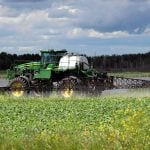(Resource News International) — The amount of area producers in Ontario seed to corn in the spring of 2009 is expected to be down from the year ago level in response to high input costs as well as reduced profitability, industry sources said.
“Fertilizer and chemical costs for corn producers in Ontario have gone up by at least 10 to 15 per cent from last year’s level with the cost of the seed also up about 10 per cent,” Don Kenny, a director for region 2 in the Ottawa-Carlton area of eastern Ontario for the Ontario Corn Producer’s Association, said.
Read Also

Sigurdson applauds Alberta farmers
With Alberta’s harvest virtually wrapped up for 2025, provincial Agriculture Minister RJ Sigurdson offered the government’s congratulations to the province’s farmers.
The increased costs will likely have caused some producers to consider alternative crops, he added.
“There are a lot of producers at this time of year, penciling out costs, researching prices, et cetera, and finding out that there are some pretty scary scenarios,” Kenny said.
A lot of producers have made decisions for the bulk of their land, he said, but it’s probably that last 100 acres that each individual holds for swing purposes that is undecided.
“The decision as to what to seed on that land also is determined by how much winterkill the province’s winter wheat crop suffers as well,” Kenny said.
If there is a lot of wheat that was damaged during the winter, there’s a good bet that producer will plough the crop under, collect his insurance and plant either corn or soybeans,” he said.
“Right now, it’s soybeans and that crop’s low input costs, that is looking attractive compared to corn,” Kenny said.
Kenny said that as a result of the high input costs, he was expecting corn acres in Ontario to be down a bit.
The Ontario Corn Producers Association (OCPA), in its own supply/demand table, estimated 2009-10 corn harvested area in Ontario at 1.7 million acres, which would be down fractionally from the 1.73 million harvested in 2008-09 and well below the 2007-08 level of 2.055 million.
“Corn area in Ontario was expected to be down as much as 15 per cent from the 2008-09 level or it could hold steady,” according to Philip Shaw, a market analyst for the OCPA, indicated in a report.
A 15 per cent drop in seeded area, however, would be hard to imagine as it would mean the least corn acres planted in Ontario in decades, Shaw said.
He also pointed out that there were 300,000 wheat acres in flux from the 2008 year and some of the 950,000 acres of wheat in the ground might get some glyphosate this spring.
With IP soybeans gaining new popularity over the winter, corn acres could also lose out, Shaw said.
Ontario and Quebec account for roughly 97 per cent of Canada’s total corn production.















